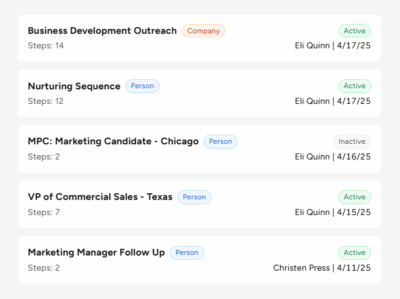If you’re a recruiting firm owner, not only do you want to bill more, but you want the other recruiters in your office billing more. You’ve probably heard this saying before: “Work smarter, not harder.” However, if you really want to maximize your earning potential, this is not an either/or situation. Ideally, you’ll work smarter AND harder.
With this in mind, we reached out to renowned industry trainer Barb Bruno of Good as Gold Training and Development. Barb is a veteran of the recruiting industry, and one of her areas of specialty is business development and revenue generation. Barb knows exactly what recruiters need to do in order to make more placements.
We have seven recruitment tips for billing more this year. However, we’ve broken these recruitment tips into three categories:
- Research and analysis
- Your recruiting desk
- The placement process
So without further adieu, let’s begin, shall we?
Recruitment tips for research and analysis
To make more placements, you need good data. And you need data that is both relevant and accurate. When you’re in possession of this data, you’re able to make better decisions about what you should do and how you should be doing it. With this in mind, below are two recruiting tips regarding research and analysis:
#1—Conduct revenue modeling.
Before you can make more placements, you have to be strategic about making more placements. The first step in this strategy is revenue modeling. This is the process of analyzing past revenue and determining:
- The source of most of your business (in terms of placements, including repeat business)
- The source of your best business (in terms of placement fees and billings)
Bruno recommends conducing revenue modeling for the previous two years. Below are a few of the questions you should ask yourself:
- Which positions did you fill most often?
- Which specific job titles did you fill the most?
- At which clients did you make the most placements?
- At which clients did you bill the most?
- Which clients represent the best job order-to-placement ratio?
According to Bruno, recruiters should devote 85% of their efforts on their best business. That includes focusing intently on those job titles that brought the most success during the past 12 months. It also includes focusing on those clients whose job orders you filled most consistently.
#2—Instruct your recruiters to conduct market research.
If you’re a firm owner, then your recruiters should be asking specific questions of candidates. These questions are geared toward helping you as the owner land new clients. They should absolutely ask the following two questions:
- Which companies do you want to work for and why?
- Which companies would you never work for and why?
So what do you do with the answers to these questions?
You heavily recruit at the companies for which candidates indicated they would never work. They indicated that for a reason, namely that these are not the most popular companies in the industry. And if they’re not the most popular, then the people who are employed there probably want to hear about new employment opportunities. Chances are good that some of these employees are passive candidates who are just RIPE for the picking.
You call the companies that candidates want to work for, if they’re not already on your client list. Then you say something along the lines of the following: “We understand that you’re one of the companies that people want to work for the most. Your name keeps popping up over and over when we speak with candidates. We represent some of the best talent in the industry, and that talent is motivated to work for your organization. What steps do I need to take so that I can provide this talent to you?”
Recruitment tips for your recruiting desk
Now that we’ve conducted the research and done the analysis, let’s turn to your recruiting desk. This is where it all happens. So it makes sense that you should have your desk running like a well-oiled machine. The better it runs, the more placements you can make. Below are three recruitment tips for your recruiting desk:
#1—Have more than one contact at a company.
Recruiters typically have only one contact at a company. However, depending upon the size of the organization, there could be five or six other people there who possess hiring authority. Not only that, but sometimes an organization will have a subsidiary or parent company. According to Bruno, the reason that recruiters don’t have the name of these other hiring authorities is because they’re not asking for their name.
“The best way to increase your flow of job orders from existing clients is to have more than one contact at a company,” she said. “Our contacts are moving more than ever before. They’re there for one or two years, and then they’re gone. Recruiters need to make sure they have two or three contacts with every one of their clients this year.”
Basically, you want to know every single person who has hiring authority or influence over the hiring decision at all of your client companies. Bruno suggests that when you get a name from your original contact, you should ask your contact to conference the other person in immediately. Once they’re on the phone, your contact should introduce you. Or if you’re meeting your contact face-to-face during an office visit, ask your contact to invite the person into the room for a formal introduction.
“That is much more powerful,” said Bruno. “If you try to call back and say, ‘So-and-so gave me your name, you’re less likely to make a genuine connection with the person.”
#2—Consider working a blended desk.
One of the best ways to get more than one contact at a client company is to ask your contact who within the organization handles contract hires. In quite a few instances, it’s a different person, and more than likely, they’ll be happy to provide you with the name. There are a couple directions you can go from here:
- If your firm already makes contract placements, but they’re handled by another division within the firm, then you can forward the new contact to that division.
- If your firm does NOT make contract placements, then this would be an opportune time to consider adding contract staffing to your recruiting desk.
Adding contract staffing will turn your direct hire desk into a blended desk, which provides you with opportunities to generate additional revenue and bill more on a year-over-year basis. The first step in doing that is securing a contract job order, which you can now secure from your brand-new contact!
#3—Develop a strong client referral program.
Recruiters miss out on business opportunities because they don’t ask their clients for referrals. Recruiters are accustomed to asking candidates for referrals, but not clients. But it can be and should be done! Because if you do not ask, then you will not receive. Of course, clients are willing to provide referrals as long as they don’t feel this new client will be a competitor to them. So you’ll have to assure them that won’t be the case.
While you can’t pay a client directly for a referral, there is an alternative: donating to that client’s favorite charity in their name. That charity could be a church or it could be a Little League baseball team. The charity is up to them. As a recruiting firm, you just have to decide what amount you’re going to donate.
Well before then, though, you must devise the parameters of your formalized client referral program. In addition to the amount, you should determine what will trigger a referral donation, the time frame involved, and the specifics of the procedure.
Recruitment tips for the placement process
Now we get to the placement process. This is where “the rubber meets the road,” so to speak. It’s also where you make the deals happen. And in the interest of helping you to make more deals, below are two recruitment tips for the placement process:
#1—Make overcoming objections a priority.
If you make marketing calls to clients (and if you follow #4 on this list, you will), then you will inevitably encounter objections. According to Bruno, changing the way you and the recruiters in your office view objections is crucial to new business development for recruiters.
“Recruiters should list the top 10 objections that they come across and brainstorm ways to overcome them,” said Bruno. “Objections are actually buying signs, basically requests for more information. Clients know what to say to get us off the phone, so you have to become great at overcoming objections in recruitment. If you don’t become great, then you’re making customer service calls and not sales calls.”
#2—Do NOT sell too quickly.
You’ve heard these phrases before, too:
- “People work with people they like.”
- “People don’t like to be sold; they like to buy.”
The reason you’ve heard them is that they’re absolutely true. However, according to Bruno, some recruiters do not take these simple truths to heart during their marketing calls. Below is a five-step blueprint for not selling too early in the process:
- Let your personality show. We’re assuming you have a personality that people will like. People work with people they like.
- Get the other person to talk.
- Shut up and listen.
- Identify what is most important to them, and forget about what is most important to you for a moment.
- Position the call (and yourself) accordingly.
“Client development is all about relationships, not instant gratification,” said Bruno. “It takes six times before somebody will even know your name, so you definitely can not start selling too early in the process.”
None of the recruitment tips outlined above are labor-intensive. Instead, they represent alternate ways of looking at existing situations, as well as corresponding action designed to help monetize those situations. In other words, even if you plan to work harder in the new year, there’s always time for working smarter.
And the recruiter who works both harder and smarter is the one who ultimately bills the most.








